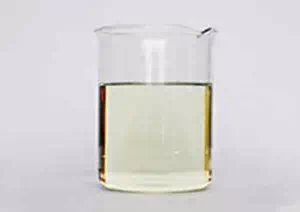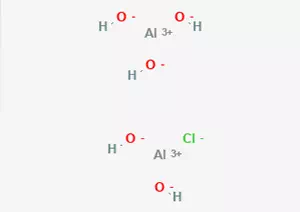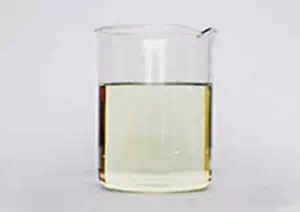All Categories



aluminum chlorohydrate CAS 12042-91-0, aluminum chlorohydrate, CAS 12042-91-0
In the vast field of chemistry, aluminium hydroxychloride, as an important inorganic polymer compound, plays a unique and crucial role.
CAS : 12042-91-0
Formula : AlClH5O-
Mol. wt. : 234-933-1
EINECS : 234-933-1
Chemical Name | Aluminum Chlorohydrate |
Other Name | Aluminum chloride hydroxide (Al2Cl(OH)5) (8CI, 9CI, ACI) |
CAS | 12042-91-0 |
EINECS | 234-933-1 |
Type | Cosmetic raw materials; Inorganic salts |
Molecular Formula | AlClH5O- |
Molecular Weight | 83.47 |
In the vast field of chemistry, aluminium hydroxychloride, as an important inorganic polymer compound, plays a unique and crucial role.
Aluminum hydroxychloride has unique chemical properties, among which its alkalinity is particularly prominent. Its alkalinity is higher than that of common polyaluminium chloride and occupies a relatively high position in the alkalinity sequence of inorganic compounds, second only to aluminium hydroxide. This relatively high alkalinity enables aluminium hydroxychloride to exhibit distinctive properties in many chemical reactions and practical applications.
From the perspective of its structural formation, aluminium hydroxide chloride is formed through hydroxyl bridging and polymerization. During this process, molecules are interconnected through hydroxyl groups, a special chemical group, forming complex polymer structures. It is worth noting that among the numerous molecules of hydroxyaluminium chloride, the one with the largest number of hydroxyl groups contains five hydroxyl groups. When this molecule exists in a solid state, it presents as a white powder-like solid, fine and uniform, as if it were composed of countless tiny particles closely piled up. When it dissolves in water to form a solution, it turns into a colorless and transparent liquid, clear and pure, just like pure water, with almost no impurities visible.
Aluminum hydroxide chloride is a product of aluminum chloride and aluminum hydroxide in terms of chemical composition. This means that it combines some characteristics of aluminium chloride and aluminium hydroxide, while also forming its own unique chemical properties. It also constructs its molecular structure through hydroxyl bridging and polymerization, but within its molecule, there exist different numbers of hydroxyl groups. This difference in the number of hydroxyl groups makes the molecular structure of aluminium hydroxychloride more diverse and complex.
In terms of appearance, aluminium hydroxide chloride usually presents as a colorless or yellow resinous solid. It looks like an elastic and sticky substance, similar in form to resin, and has a certain degree of flexibility and plasticity. When it dissolves in water to form a solution, the solution appears as a colorless or yellowish-brown transparent liquid. This solution gives off a faint luster under the illumination of light, being transparent and clear. However, in some cases, due to the possible presence of impurities in it, the color of the solution may change to a certain extent. Sometimes it will present a grayish-black viscous state, with increased viscosity and a darker color.
Aluminum hydroxychloride also has a remarkable characteristic, that is, it has a very strong bridging and adsorption performance. This performance enables it to have extensive applications in many fields. It can act like a bridge, connecting different substances together and achieving adsorption and combination between substances. Meanwhile, aluminium hydroxide chloride is highly soluble in water, which enables it to disperse and dissolve rapidly in water and undergo chemical reactions with other substances, thereby exerting its unique role.
When aluminium hydroxychloride comes into contact with water and undergoes hydrolysis, this process is not merely a simple chemical reaction but is accompanied by a series of complex physical and chemical processes. During this process, the molecular structure of aluminium hydroxychloride changes and interacts with water molecules to produce various intermediate and final products. These changes not only involve the breaking and formation of chemical bonds, but also include physical processes such as the rearrangement of molecules and changes in conformation.
In today's water treatment field, aluminium chloride hydrate, as an extremely important flocculant, is widely used in the treatment of domestic water, drinking water and municipal water. It plays an indispensable and crucial role throughout the water treatment process, providing strong support for ensuring water quality safety and optimizing water treatment effects.
The preparation process of this product, hydrated aluminium chloride, is very rigorous and scientific. It is carefully formulated from pure aluminium and pure hydrochloric acid. This unique formulation method ensures that the product has a high degree of purity and stability, laying a solid foundation for its outstanding performance in water treatment. It is worth mentioning that the specifications of hydrated aluminium chloride strictly comply with the requirements of the internationally recognized drinking water treatment standard USP-34. This standard is an important measurement criterion for the quality of drinking water treatment chemicals worldwide, fully demonstrating the reliability of this product in terms of quality and safety.
In terms of advantages
Enhancing turbidity removal capacity and flocculation speed: Hydrated aluminium chloride can significantly improve the turbidity removal capacity in the water treatment process, enabling impurities and suspended solids in water to coagulate into larger particles more rapidly, thereby accelerating the flocculation speed. In actual water treatment scenarios, this means that more efficient water purification can be achieved in a shorter time, significantly enhancing the efficiency of water treatment and reducing treatment time and costs.
Improving TOC (Total Organic Carbon) removal: For total organic carbon in water, hydrated aluminium chloride has demonstrated an outstanding removal effect. It can interact with organic substances in water, effectively adsorb and aggregate them together, and then remove them from the water through sedimentation and other methods. This not only helps improve the taste and smell of water, but also further ensures the safety of drinking water and reduces potential health risks.
Reducing turbidity through filters, shortening the filtration process, and enhancing production capacity: As hydrated aluminium chloride can efficiently remove impurities and suspended solids from water, the turbidity of water is significantly reduced. In this way, in the subsequent filtration process, the demand for turbidity filtration devices is correspondingly reduced, and the filtration process becomes smoother and more efficient. Meanwhile, the entire water treatment process has been shortened, significantly enhancing the production capacity of water treatment facilities and meeting the growing water demand.
Enhance the removal capacity of fluorine, cadmium, radioactive pollution and floating oil: When dealing with various pollutants in water, hydrated aluminium chloride has demonstrated a powerful removal capacity. For fluoride ions, it can fix or transform them through specific chemical reactions, thereby reducing the fluoride content in water. For heavy metal pollutants like cadmium, hydrated aluminium chloride can form insoluble compounds with it, causing it to precipitate out of water. For radioactive pollution, it can also play an adsorption and fixation role to a certain extent, reducing its diffusion and harm in water. For floating oil, hydrated aluminium chloride can disrupt its emulsified state, promoting the aggregation and floating of the floating oil, which is convenient for separation and removal from water.
Reduce the use of reagents, simplify the operation process and eliminate the influence of pH value. No secondary electrolyte is added: The use of hydrated aluminium chloride can effectively reduce the usage of other auxiliary reagents and simplify the entire water treatment operation process. In traditional water treatment processes, it is often necessary to add various reagents to regulate water quality and treat pollutants. However, the comprehensive performance of hydrated aluminium chloride makes these additional operations no longer necessary. Meanwhile, it can also eliminate the influence of pH value on water treatment effect. No matter what the initial pH value of the water is, it can maintain a stable treatment effect. Moreover, during the usage process, no secondary electrolyte needs to be added, further reducing the complexity and cost of the operation.
Reducing the production cost of tap water: By integrating all the above advantages, the use of hydrated aluminium chloride can significantly reduce the production cost of tap water. By enhancing treatment efficiency, reducing reagent usage, and shortening the process flow, the entire water treatment process has become more economical and efficient, saving a significant amount of operating costs for waterworks and providing users with high-quality water sources that offer better value for money.
Adding decolorization function: Hydrated aluminium chloride also has an excellent decolorization function, which can effectively remove various pigment substances in water, making the treated water clearer and more transparent, and improving the appearance quality of the water.
Cleaning TSS (Total Suspended Solids) : For total suspended solids in water, hydrated aluminium chloride can play a powerful cleaning role. It can rapidly coagulate and settle these suspended solids, making the water clearer, reducing the wear of solid substances in the water on pipelines and equipment, and extending the service life of the equipment.
Removal of heavy metals such as lead, cadmium (Cd), mercury (Hg), and chromium (Cr6+) : In today's increasingly serious heavy metal pollution, hydrated aluminium chloride plays a significant role in the removal of heavy metals. It can undergo chemical reactions with heavy metal ions such as lead, cadmium, mercury and chromium (Cr6+) to form stable precipitates, thereby removing them from water, ensuring the safety of drinking water and preventing the potential harm of heavy metals to human health.
Removal of phosphorus, fluorine and oily suspended solids: Hydrated aluminium chloride also has a very good removal effect on phosphorus, fluorine and oily suspended solids. For phosphorus, it can be fixed through chemical precipitation to prevent eutrophication of water bodies. For fluorine, as mentioned earlier, its content can be effectively reduced. For oily suspended solids, it can disrupt their stability and promote their aggregation and sedimentation, reducing the pollution of oil substances to water bodies.
Reduce sludge by 50% : During the water treatment process using hydrated aluminium chloride, the amount of sludge produced is significantly reduced compared to traditional treatment methods, by approximately 50%. This not only reduces the cost and difficulty of sludge treatment, but also minimizes secondary pollution to the environment, which is in line with modern environmental protection concepts.
Once again, it is emphasized to reduce the use of reagents, simplify the operation process and eliminate the influence of pH value. No secondary electrolyte is added. Reducing the production cost of tap water: These advantages of hydrated aluminium chloride have been fully demonstrated in practical applications. By reducing the use of reagents and simplifying the operation process, not only has the work efficiency been improved, but also the possibility of human operational errors has been reduced. Meanwhile, eliminating the influence of pH value makes the water treatment process more stable and reliable, and not adding secondary electrolyte further reduces costs and environmental risks, ultimately achieving an effective reduction in the production cost of tap water.
Effective reduction of COD, BOD and TOC in white water: When treating white water, hydrated aluminium chloride can significantly reduce the chemical oxygen demand (COD), biochemical oxygen demand (BOD) and total organic carbon (TOC) in it. This is of great significance for protecting the environment and reducing water pollution. At the same time, it also saves the cost of sewage treatment for enterprises and improves the efficiency of water resource recycling.
* Prompt reply and 24 hours online, professional team to provide best price and high quality product.
* Sample testing support.
* Every batch of products will be tested to ensureits quality.
*The packing also can be according the customers` requirment.
*Any inquiries will be replied within 24 hours.
*we provide Commerical Invoice, Packing List, Bill of loading, COA , Health certificate and Origin certificate. If your markets have any special requirements, let us know.